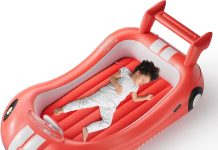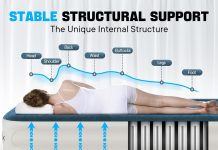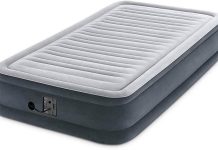In today’s article, we explore a topic that has crossed everyone’s mind at some point: How long should an air mattress last? Whether you’re a frequent camper, host overnight guests regularly, or even use an air mattress as your primary bed, it’s essential to understand the lifespan of this versatile sleeping solution. We’ll delve into various factors that impact an air mattress’s durability and provide you with some practical tips on how to extend its lifespan. So, if you’ve ever wondered about the longevity of your inflatable bed, keep reading to uncover the secrets behind a long-lasting and comfortable snooze.
Review contents
Factors Affecting the Lifespan of an Air Mattress
When it comes to the lifespan of an air mattress, several factors come into play. Understanding these factors can help us make informed decisions about the quality and durability of the air mattress we choose. Let’s explore some of the key factors that can affect the longevity of an air mattress.
Quality of Materials
The quality of materials used in the construction of an air mattress plays a significant role in determining its lifespan. High-quality materials, such as thick and durable PVC or rubber, are more likely to withstand regular use and resist wear and tear. On the other hand, low-quality materials may be prone to punctures, leaks, and deterioration over time. It is essential to consider the quality of materials when purchasing an air mattress to ensure its durability and longevity.
Frequency of Use
The frequency of use is another crucial factor that affects the lifespan of an air mattress. If an air mattress is used frequently, it will naturally experience more wear and tear, potentially leading to a shorter lifespan. On the contrary, occasional or seasonal use may result in a longer lifespan. Considering the intended frequency of use can help us choose an air mattress that is suitable for our specific needs and ensure that it lasts as long as possible.
Weight Capacity
The weight capacity of an air mattress refers to the maximum weight it can support without compromising its integrity and performance. Exceeding the weight capacity can put excessive strain on the mattress, leading to deformities, leaks, or even total failure. It is crucial to consider the weight capacity of an air mattress and select one that can comfortably accommodate the intended users. By adhering to the weight capacity guidelines, we can prolong the lifespan of the air mattress and ensure its optimal performance.
Temperature and Humidity
Temperature and humidity can also influence the lifespan of an air mattress. Extreme temperatures and high humidity levels can cause the materials to expand, contract, or deteriorate over time. Exposure to excessive heat or moisture can weaken the structure of the air mattress, making it more prone to leaks and damage. It is essential to store the air mattress in a suitable environment and avoid exposing it to extreme conditions to maximize its lifespan.
Storage and Maintenance
Proper storage and maintenance are vital for extending the lifespan of an air mattress. When not in use, it is crucial to deflate the mattress fully and store it in a clean and dry place. Folding or rolling the mattress can cause stress on the seams, potentially leading to leaks or damage. Regular cleaning and inspection can also help identify any potential issues and address them promptly, ensuring the longevity of the mattress.
Average Lifespan of Different Types of Air Mattresses
The lifespan of an air mattress can vary depending on its type and quality. Let’s take a closer look at the average lifespan of different types of air mattresses available in the market:
Low-End Air Mattresses
Low-end air mattresses, typically characterized by lower price points, are generally made with less durable materials. These mattresses might last anywhere from a few months to a year with regular use. While they may be suitable for occasional use or short-term needs, they may not provide the longevity required for regular or long-term use.
Mid-Range Air Mattresses
Mid-range air mattresses offer a balance between affordability and quality. These mattresses often feature better materials and construction, providing increased durability and lifespan. With proper care and maintenance, mid-range air mattresses can last anywhere from one to three years, depending on frequency of use and other factors.
High-End Air Mattresses
High-end air mattresses are constructed with top-of-the-line materials and advanced design features. These mattresses tend to be more durable and offer better longevity compared to their low-end and mid-range counterparts. With proper care and maintenance, high-end air mattresses can last anywhere from three to five years or more. While they may come with a higher price tag, the investment in a high-quality air mattress can be worthwhile for those seeking long-term comfort and durability.
Signs of Deterioration and Potential Health Risks
Over time, air mattresses can deteriorate and pose potential health risks if not properly maintained or replaced when necessary. Let’s explore some of the signs of deterioration and potential health risks to be aware of:
Loss of Air Pressure
One common sign of an aging air mattress is a loss of air pressure. If you find yourself having to reinflate your mattress more frequently or waking up to a partially deflated mattress, it may be a sign of deterioration. A loss of air pressure can affect the overall comfort and support provided by the mattress, and continued use may lead to discomfort and disrupted sleep.
Visible Wear and Tear
Visible wear and tear, such as cracks, punctures, or fraying seams, are clear indicators that an air mattress is deteriorating. These signs of damage can compromise the structural integrity of the mattress and increase the risk of leaks or complete failure. It is important to regularly inspect the air mattress and address any visible wear and tear promptly to ensure continued safety and performance.
Mold and Mildew Growth
Improper storage or exposure to moisture can lead to the growth of mold and mildew on an air mattress. Mold and mildew not only deteriorate the material of the mattress but also pose health risks to users. The presence of mold or mildew can cause respiratory problems, allergies, and other health issues. If mold or mildew is present on an air mattress, it is necessary to replace it to maintain a safe and healthy sleeping environment.
Allergens and Dust Mites
Air mattresses, especially those not regularly cleaned and maintained, can become a breeding ground for allergens and dust mites. These microscopic pests can cause allergies and respiratory problems for individuals who are sensitive to them. Regular cleaning and maintenance, including thorough vacuuming and using allergen-proof covers, can help reduce the risk of allergens and dust mites on an air mattress.
Tips for Extending the Lifespan of an Air Mattress
While the lifespan of an air mattress may vary, there are several steps we can take to maximize its longevity. Here are some useful tips for extending the lifespan of an air mattress:
1. Choose a Durable Air Mattress
Investing in a durable air mattress made with high-quality materials is the first step in ensuring its longevity. Look for mattresses with thick and puncture-resistant materials, reinforced seams, and reliable air valves. Reading customer reviews and seeking recommendations can also help identify models known for their durability.
2. Follow Weight Capacity Guidelines
Always adhere to the weight capacity guidelines provided by the manufacturer. Overloading an air mattress with excessive weight can put strain on the materials and lead to deterioration or failure. Ensure that the weight of all users, as well as any additional weight from bedding or accessories, falls within the recommended limits.
3. Properly Inflate and Deflate
Properly inflating and deflating the air mattress is essential for maintaining its integrity. Avoid overinflating or underinflating, as it can cause strain on the seams or create discomfort during use. Follow the manufacturer’s instructions for inflation and deflation, and avoid using sharp or pointed objects when handling the mattress.
4. Store in a Suitable Environment
When not in use, store the air mattress in a clean, dry, and temperate environment. Avoid exposing it to extreme temperatures, direct sunlight, or high humidity. Folding or rolling the mattress for storage can stress the seams and increase the risk of damage. Consider using a storage bag or container designed specifically for air mattresses to protect it from dust and potential damage.
5. Clean and Maintain Regularly
Regular cleaning and maintenance can significantly extend the lifespan of an air mattress. Wipe down the surface of the mattress with a mild detergent or cleaner occasionally to remove dirt, sweat, and oils. Ensure that the mattress is completely dry before deflating and storing it to prevent the growth of mold or mildew. Additionally, inspect the mattress regularly for any signs of wear and tear, and address them promptly to avoid further damage.
When to Replace an Air Mattress
While proper care and maintenance can help prolong the lifespan of an air mattress, there are instances where replacement becomes necessary. Here are some indications that it may be time to replace an air mattress:
1. Persistent Leaks
If an air mattress develops persistent leaks that cannot be effectively patched or repaired, it may be time for a replacement. Leaks can significantly impact the comfort and functionality of the mattress, and continued use may lead to further damage or complete failure.
2. Irreparable Damage
In cases where the air mattress has sustained irreparable damage, such as large punctures, extensive tears, or structural deformities, replacement is the best course of action. Trying to continue using a mattress with irreparable damage can compromise safety, support, and overall sleep quality.
3. Health and Safety Concerns
If an air mattress shows signs of mold, mildew, or significant allergen buildup, it poses health and safety risks to users. These concerns should not be taken lightly, and replacing the mattress is essential to maintain a clean and healthy sleeping environment.
4. Comfort and Support
Over time, an air mattress may lose its original level of comfort and support due to wear and tear or deterioration. If repeated attempts to address these issues prove unsuccessful, it may be time to consider replacing the mattress to ensure a good night’s sleep.
Conclusion
The lifespan of an air mattress is influenced by various factors, including the quality of materials, frequency of use, weight capacity, temperature and humidity, and proper storage and maintenance. Understanding these factors and following the tips provided can help us maximize the longevity of our air mattress. Regular inspection, cleaning, and prompt addressing of any signs of wear and tear are crucial for maintaining a safe and comfortable sleep surface. If an air mattress develops persistent leaks, irreparable damage, health and safety concerns, or significant comfort and support issues, it is advisable to consider replacing it. By being mindful of these factors and following the proper care guidelines, we can ensure the longevity and optimal performance of our air mattress.































